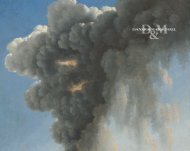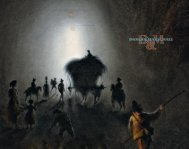Catalogue 2010 - daxer & marschall
Catalogue 2010 - daxer & marschall
Catalogue 2010 - daxer & marschall
Create successful ePaper yourself
Turn your PDF publications into a flip-book with our unique Google optimized e-Paper software.
VILHELM HAMMERSHøI<br />
Provenance:<br />
Einer Koch (c.1918) 7<br />
Copenhagen, Kunsthallen,<br />
Købmagergade, auction 280,<br />
1968, lot 89<br />
Olof Sager, Malmö 8<br />
Exhibited:<br />
Vilhelm Hammershøi,<br />
Kunstmuseum Göteborg,<br />
1999 - 2000, p.116,<br />
no. 37, repr.<br />
Vilhelm Hammershøi, Stockholm,<br />
Nationalmuseum,<br />
18.02.-07.03.2000, p. 116,<br />
no. 37, repr.<br />
Literature:<br />
Sophus Michaëlis and Alfred Bramsen,<br />
Vilhelm Hammershøi - Kunstneren og hans<br />
vaerk,<br />
Copenhagen and Christiana 1918, p.<br />
104, no. 271, as Stue [room] 1905<br />
46<br />
The two main elements that are highlighted are the chair – the focal point – and the near end of the<br />
tall bookcase in the foreground. This accentuation recalls a convention used in history painting where<br />
a frontally rendered figure in the foreground leads into the narrative and the composition is closed by a<br />
figure rendered from behind in the background. 9<br />
Yesterday I saw Hammershöj for the first time ... I am sure the more one sees of him, the more clearly one would be<br />
able to make him out, and the more one would appreciate his fundamental simplicity. I will see him again without speaking<br />
to him, since he speaks only Danish and understands very little German. One has the feeling that all he does is paint, and<br />
that this is all he is able or willing to do.<br />
This is how Rainer Maria Rilke (1875-1926) described his meeting with Hammershøi in<br />
Copenhagen in December 1904. Rilke had first seen Hammershøi’s paintings at the International<br />
Exhibition staged at the Städtischer Kunstpalast in Düsseldorf and had developed a growing<br />
interest in his work. The meeting was arranged by Alfred Bramsen (1851-1932). Rilke was planning to publish<br />
an article about Hammershøi in Die Zeit and to write an essay on him. Probably rebuffed both by the brevity<br />
of the meeting and by Hammershøi’s reticent and monosyllabic manner, he was unable to go ahead with<br />
either project. The meeting gave him insufficient opportunity, he later said, ‘to gather views and insights’ 10<br />
into Hammershøi’s life and work. Rilke relocated the focus of his activities to Paris in 1905 where he worked<br />
as secretary to Auguste Rodin.<br />
Hammershøi entered the Copenhagen Academy of Art in 1879 and completed his studies in 1885.<br />
His first exhibited painting was a portrait of a girl. This was shown at the Academy’s Charlottenborg Spring<br />
Exhibition in 1885. A painting titled Bedroom was turned down by the jury of the Academy in 1890. After that,<br />
he exhibited with the artists’ association known as Frie Udstilling [‘Free Exhibition’] set up by the Danish artist<br />
Johan Rohde. Hammershøi married Ida Ilsted (1869-1949), the younger sister of his associate and friend<br />
Peter Ilsted, in 1891. Ida was his model in a great many of his paintings of interiors. The couple travelled<br />
extensively in Europe. The influential Berlin-based art dealer Paul Cassirer (1871-1926) purchased several<br />
of Hammershøi’s paintings in 1905 and staged a solo show of his work at the Hamburg branch of his gallery.<br />
Hammershøi exhibited at the Exposition universelle in Paris in 1889 and again in 1900. He showed at the<br />
Venice Biennale in 1903 and at numerous exhibitions in Germany, England, Russia and the united States.<br />
After his death the contents of his studio were dispersed at an auction held on 30 October 1916. His œuvre<br />
lapsed into obscurity and was only rediscovered in the 1970s with the critical re-evaluation of Symbolism. 11<br />
7. Einer Koch also owned a landscape by Vilhelm Hammershøi executed in 1909. See S. Michaëlis and A. Bramsen, Vilhelm Hammershøi -<br />
Kunstneren og hans vaerk, Copenhagen and Christiana 1918, no. 318, p. 108.<br />
8. Olof Sager, Professor of English at the university of Lund, was an important collector.<br />
9. This can probably be interpreted as a reversion to the compositional conventions of painters such as Nicolas Poussin.<br />
10. Poul Vad, ‘Vilhelm Hammershøi and Rainer Maria Rilke’ in Akzente: Zeitschrift für Literatur, XLIII, 6, 1996, pp. 562-71 and p. 574 (the<br />
present quote).<br />
11.Vilhelm Hammershøi, op. cit., p. 127. Hammershøi’s relationship to the Symbolist movement is ambivalent. His painting titled Artemis,<br />
exhibited with the Frie Udstilling association in 1894, has been described as ‘a key work in the history of Danish art’, symptomatic of ‘the<br />
breakthrough of the Symbolist aesthetic’. However it is unclear as to what extent Hammershøi identified himself with the Symbolists,<br />
particularly in view of his negative comments regarding a Symbolist exhibition he had visited in Paris (see Vilhelm Hammershøi, op. cit.,<br />
p. 14).<br />
.






